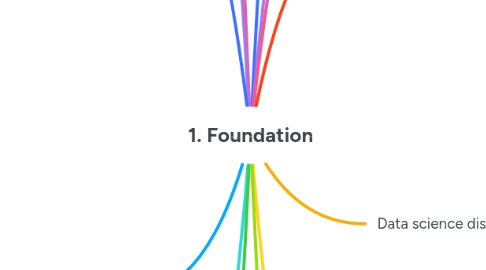
1. Data ecosystem
1.1. definition
1.1.1. the various elements that interact with one another in order to produce, manage, store, organize, analyze, and share data
1.1.2. cloud: a place to keep data online, rather than a computer hard drive
1.2. data-driven decision-making
1.2.1. using facts to guide business strategy
1.2.1.1. 1st step: figure out the business need
1.2.2. subject matter experts
2. Data vs Gut instinct
2.1. gut instinct is an intuitive understanding of something with little or no explanation
2.2. data + business knowledge = mystery solved
2.2.1. What kind of results are needed?
2.2.2. Who will be informed?
2.2.3. Am I answering the question being asked?
2.2.4. How quickly does a decision need to be made?
3. Analytical skills
3.1. qualities and characteristics associated with solving problems using facts
3.1.1. curiosity
3.1.2. understanding context
3.1.2.1. context is the condition in which something exists or happens
3.1.2.2. counting one to five
3.1.3. having a technical mindset
3.1.3.1. a technical mindset is the ability to break things down into smaller steps or pieces and work with them in an orderly and logical way
3.1.4. data design
3.1.4.1. how you organize information
3.1.5. data strategy
3.1.5.1. the management of people, processes and tools used in data analysis
4. Analytical thinking
4.1. identifying and defining a problem and then solving it by using data in an organized, step-by-step manner
4.1.1. visualization
4.1.1.1. the graphical presentation of information
4.1.1.1.1. graphs, maps or other design elements
4.1.2. strategy
4.1.3. problem-orientation
4.1.4. correlation
4.1.4.1. relationship
4.1.4.2. does not equal causation
4.1.5. big-picture and detail-oriented thinking
4.2. questions
4.2.1. What is the root cause of the problem?
4.2.1.1. root cause is the reason why a problem occurs
4.2.1.2. ask 5 Whys
4.2.2. Where are the gaps in our process?
4.2.2.1. gap analysis
4.2.2.1.1. a method for examining and evaluating how a process works currently in order to get where you want to be in the future
4.2.3. What did we not consider before?
5. Data-driven decision-making
5.1. using facts to guide business strategy
6. Data analysis process
6.1. Ask
6.1.1. ask effective questions
6.1.2. define the problem
6.1.3. use structured thinking
6.1.4. communicate with others
6.2. Prepare
6.2.1. understand how data is generated and collected
6.2.2. identify and use different data formats, types, and structures
6.2.3. make sure data is unbiased and credible
6.2.4. organize and protect data
6.3. Process
6.4. Analyze
6.5. Share
6.6. Act
7. Data analysis
7.1. **data analysis** life cycle
7.1.1. ask
7.1.1.1. ask questions and define the problem
7.1.1.1.1. Business Challenge/Objective/Question
7.1.2. prepare
7.1.2.1. prepare data by collecting and storing the information
7.1.2.1.1. Data generation, collection, storage, and data management
7.1.3. process
7.1.3.1. data by cleaning and checking the information
7.1.3.1.1. Data cleaning/data integrity
7.1.4. analyze
7.1.4.1. data to find patterns, relationships, and trends
7.1.4.1.1. Data exploration, visualization, and analysis
7.1.5. share
7.1.5.1. data with your audience
7.1.5.1.1. Communicating and interpreting results
7.1.6. act
7.1.6.1. on the data and use the analysis results
7.1.6.1.1. Putting your insights to work to solve the problem
7.2. vs Data analytics: is the science of data
7.3. the collection, transformation, and organization of data in order to draw conclusions, make predictions, and drive informed decision-making
8. Data analyst
8.1. someone who collects, transforms, and organizes data in order to help make informed decisions
9. Computer + Your brain + Your skills + Your traits = Job success
10. Data analytics in everyday life
10.1. improve processes
10.2. identify opportunities and trends
10.3. launch new products
10.4. serve customers
10.5. make thoughtful decisions
11. Data science disciplines
11.1. Machine learning
11.1.1. make many decisions under uncertainty
11.1.2. excellence is performance
11.2. Analytics
11.2.1. encounter your unknown unknowns
11.2.2. excellence is speed
11.3. Statistics
11.3.1. make a few decisions under uncertainty
11.3.2. excellence is rigor, very careful about protecting decision-makers from making the wrong decisions
12. **Data** life cycle
12.1. plan
12.1.1. define what kind of data is needed, how it will be managed, and who will be responsible for it
12.2. capture
12.2.1. collect or bring in data from a variety of different sources
12.3. manage
12.3.1. care for and maintain the data
12.4. analyze
12.4.1. use data to solve problems, make good decisions, and support business goals
12.5. archive
12.5.1. keep relevant data stored for long-term and future reference
12.6. destroy
12.6.1. remove data from storage and delete shared copies of the data
13. Data analyst tools
13.1. query language
13.1.1. a computer programming language that allows you to retrieve and manipulate data from a database
13.1.1.1. MySQL
13.1.1.2. Microsoft SQL Server
13.1.1.3. BigQuery
13.2. spreadsheet
13.3. data visualization
13.3.1. Tableau
13.3.2. Looker
13.3.3. data visualizations are pictures. They are wonderful ways to take very basic ideas about data and data points and make them come alive
